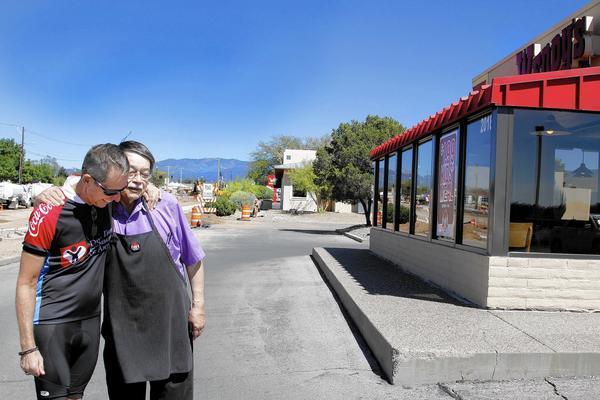By Leslie Mann
Chicago Tribune
WWR Article Summary (tl;dr) Wendy’s franchise owner Ed Anderson of Newport News, Va., spent his summer vacation riding his bicycle across the U.S., during his “Tour de Adoption.” By riding across the country, Anderson encouraged people to donate to the Dave Thomas Foundation for Adoption. So far, $340,000 has been raised, and the money is still rolling in.
Chicago Tribune
By the time Natasha Santos, now 28, was adopted, she was 16 and had lived with six foster families. To would-be adoptive parents, the New York City resident says, “It’s not too late. You’ll make a difference in their lives. And parenting doesn’t stop when we turn 18. I group-text with my mom and siblings every day.”
Although she spent years in foster care, Santos counts herself as one of the lucky ones. About 60,000 foster-care kids, newborn to 18, await adoption, said Children’s Rights, a national advocacy group. Another 355,000 foster kids are not candidates for adoption because their birthparents haven’t terminated their parental rights.
And this, said Ed Anderson, 59, of Newport News, Va., is why he spent his summer vacation riding his bicycle across the U.S., during his “Tour de Adoption.”
“Kids are in foster homes through no fault of their own,” Anderson told folks he met along the way.
The co-owner of 11 Wendy’s restaurants, Anderson has long supported the Dave Thomas Foundation for Adoption, named for and established by the Wendy’s founder to increase the number of adoptions of kids from foster homes. By riding across the country, Anderson could encourage people to donate to the foundation, he predicted. So far, $340,000 has been raised, and the money is still rolling in.
Anderson started his ride July 25 in Virginia Beach, Va. Ten weeks later, Oct. 4, he reached the Pacific Ocean in San Diego.
His wife, Judy, and two of their three sons, Eddie and Joey, took turns following him in their van and lining up motels and pit stops that included 21 Wendy’s restaurants whose owners asked to be on his map. Anderson praised Judy for packing “an extra everything, from bike tire to helmet.”
Even at the most remote stops, Anderson was a magnet for foster and adoptive families who saw his Tour de Adoption logo on the van.
“Despite what we see on the news every night, our country is filled with kind, friendly people,” said Anderson. “We met so many people like Curt and Rhonda, mom-and-pop motel owners who did our laundry. Or, the front-desk guy at another place who saw my legs and switched us to a room with a tub, so I could soak.”
In Southern Illinois, a farmer stopped his tractor to call his radio-reporter brother, who did an impromptu interview about adoption with Anderson.
The Donaldson Adoption Institute’s 2015 Adoption Perceptions Study found that 60 percent of Americans have a friend or family member who is part of the adoption triad: adoptee, adoptive parent or birthparent.
After Anderson threw out the first pitch for the River City Rascals in O’Fallon, Mo., a little boy introduced himself and his soon-to-be adoptive parents.
When Anderson had food poisoning in Anton, Colo., the owner of the rural motel where he and Judy stayed one night drove Judy 60 miles round-trip to buy him ginger ale and saltines. She and Judy had plenty to talk about. She was a foster mom.
Anderson’s timing of his tour was right-on, said Adam Pertman, president of the National Center on Adoption and Permanency in Boston and Los Angeles.
“The demographics of adoption have changed dramatically in the last few decades,” said Pertman. No longer is the average adoptee a healthy infant. Now, the median age is 6.8 years, according to the U.S. Department of Health and Human Services, and, often, the child is part of a sibling group. Adoptive parents are not necessarily young, heterosexual same-race couples.
“Closed adoption” is becoming a thing of the past, said Pertman. Today, most adoptions of babies are open.
“That means, in the vast majority of cases, you know who the birth mom is, and probably other family members as well,” said Pertman. “And, increasingly, even international adoptions are becoming open too,” he said.
Adoption social services and laws are playing catch-up. Laws vary greatly from state to state. But more than that, said Pertman, it’s a matter of rethinking where adoption is today.
buy acyclovir generic buy acyclovir online no prescription
“The old model is ‘child placement,'” said Pertman. “How many kids did we place in adoptive homes today? The new model is ‘family success.’ Did we provide the family with pre-, during-, and post-adoption services to ensure the child, or sibling group, has a forever home?”
Like many older adoptees, for example, Santos had learned to live with scars, in her case, from emotional and verbal abuse from a former foster mom. Finally, adoption gave her the security she needed, said Santos. That, in turn, gave her confidence, which she said is valuable socially and professionally.
Despite a small army of volunteers like Anderson who make adoption their mission, about 22,000 foster children “age out” of foster care each year because they turn 18 without having been adopted, according to Children’s Rights. As adults, they’re much more likely than their adopted peers to become homeless, unemployed or incarcerated, and much less likely to earn a college degree.
While Anderson raises money for the foundation to tackle aging out and other adoption concerns, Santos (a professional community organizer) cuts right to the chase. “Are you an adoptive parent?” she asks you when you meet. If your answer is “No,” she fires back: “Why not?” To you, her community looks like New York City. But to her, it is one huge pool of potential adoptive parents.














































































































































































































































































































































































